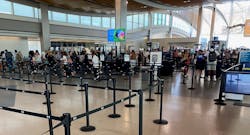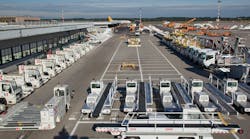The Transportation Security Administration (TSA) at Sacramento International Airport (SMF) is screening a record number of travelers through the airport’s security checkpoints. Current passenger volumes are more than 10% of 2019, pre-pandemic volumes. With sustained high passenger volumes locally and at airports nationwide, TSA is encouraging travelers to plan ahead and be prepared every step of the air travel experience.
During the first 12 days of July, TSA has screened more than 29.5 million people at 430 airports nationwide, which is an average of more than 2.46 million people per day. Friday, June 30 was the busiest day ever for TSA operations nationally when 2,884,887 people were screened.
At SMF, the busiest day ever for TSA screening operations was also Friday, June 30 when 22,558 people were screened through the airport’s security checkpoints. Since, July 1, TSA has screened more than 215,500 people. For the remainder of the summer, TSA is projecting an increase in the number of travelers who will need to be screened at the security checkpoints at SMF. Planning ahead, arriving early and being prepared will be crucial to make security operations go smoothly.
Security checkpoint info
The busiest times at the SMF security checkpoints are 4:00 a.m. to 6:00 a.m. and 12:00 p.m. to 2:00 p.m. Due to an increased number of flights that depart in the early morning and early afternoon, travelers can expect to encounter large numbers of travelers being screened during those times. The busiest days to travel are Thursdays and Fridays as well as Sundays and Mondays.
“We are pleased to see that the public is traveling again! The security checkpoints are busy and we are staffed to deliver an effective and efficient security screening experience,” said TSA Federal Security Director at SMF Sid Hanna.
Changes to TSA PreCheck screening
TSA PreCheck expedites a traveler’s airport security checkpoint screening process and allows travelers to leave on their shoes, light outerwear and belt, keep their laptop in its case and their travel size liquids, gels and aerosols in a carry-on. More than 15 million people nationwide have enrolled in TSA PreCheck and regularly enjoy the expedited screening process when they travel.
TSA offers dedicated TSA PreCheck lanes for travelers departing SMF’s Terminal A and Terminal B.
Previously, children 12 and under have been permitted to use the TSA PreCheck lane when traveling with an eligible parent or guardian on the same itinerary. Starting this summer, teenagers ages 13-17 can now accompany TSA PreCheck enrolled parents or guardians through TSA PreCheck screening when traveling on the same reservation and when the TSA PreCheck indicator appears on the teen’s boarding pass.
On average, 88% of TSA PreCheck-eligible travelers waited five minutes or less to be screened in June 2023. TSA PreCheck enrollment is offered at SMF’s Terminal B baggage claim as well as at six other locations in the metro area.
Summer travel tips
Travelers have the ability to impact the efficiency of the airport travel experience. Because there is no substitute for being prepared, TSA recommends the following:
Pack smart. Travelers should be aware of the contents of their carry-on bags prior to leaving home. Ensure that carry-ons do not contain prohibited items since they slow down the security screening process. To determine whether an item is allowed or prohibited in carry-on luggage, download the MyTSA app and use the “What Can I Bring?” feature. Another option is to snap a picture of an item and send it to @AskTSA on Twitter or Facebook Messenger for real-time assistance. Travelers can also send a question by texting “Travel” to AskTSA (275-872).
Use your time wisely in the security checkpoint queue. Have your photo ID ready. Don’t wait until you approach the TSA officer who is checking IDs to look for it. Empty your pockets prior to arrival in the checkpoint. Place wallets, phones, keys, sunglasses and other loose items from your pockets inside your carry-on bag instead of placing them in a bin. This will ensure personal items are not left behind.
Listen for guidance from TSA officers. Whether you travel regularly or infrequently, it is important to listen to the direction provided in the security checkpoint. SMF has security screening technologies in use that may allow travelers not to present a boarding pass during the travel document checking process or leave all items in their carry-on luggage as it is screened by the X-ray. Listen up for directions that will make for a more streamlined, convenient and time-saving passenger experience.
Follow the rule for traveling with liquids. Sunscreen, creams, bug spray and other liquids and aerosols are limited to 3.4 ounces (100 ml) or less in carry-on luggage. If a traveler brings liquids in quantities larger than 3.4 ounces, TSA will have to conduct a bag check, which slows the screening process for that traveler and everyone in line behind them. Any liquids in quantities larger than 3.4 ounces should travel in checked baggage.
Eligible for TSA PreCheck? Enter your Known Traveler Number (KTN). Be sure that your airline reservation has your correct KTN and date of birth so you can “Travel with Ease.” Those who fly with multiple airlines should ensure their KTN is updated in each of their airline profiles every time you travel. TSA offers the TSA PreCheck experience at every airport nationwide, so this is a guaranteed way to save time and have a more convenient experience.
Traveling with a firearm on a commercial aircraft. Earlier this week, TSA announced that it has intercepted 3,251 firearms at airport checkpoints nationwide during the first half of 2023. That is an average of 18 firearms per day at TSA checkpoints, of which more than 92% were loaded. This is an increase from the first half of 2022 when TSA officers discovered 3,053 firearms at security checkpoints, of which more than 86% were loaded.
At SMF, TSA officers have discovered 22 firearms in travelers’ carry-on luggage so far this year. At the same point in 2022, TSA had found 20 firearms at the security checkpoint.
The most recent TSA firearm discovery at SMF occurred Saturday, July 8 around 11 a.m. during the routine X-ray screening of carry-on luggage. The firearm - a loaded 9mm Glock 26 - and 10 rounds of ammunition were in the bag of a traveler ticketed for travel to Seattle-Tacoma International Airport. This is the second firearm discovered by TSA so far this month at SMF.
TSA will review the circumstances of the firearm incident and levy a civil penalty against the passenger. The recommended civil penalty for a firearm starts at $2,050 and can go up to the statutory maximum of more than $14,950 per violation. TSA evaluates each incident on a case-by-case basis.
In addition to civil penalties, individuals who violate rules regarding traveling with firearms will have TSA PreCheck® expedited screening benefits revoked for a period of time. The duration of the disqualification will depend upon the seriousness of the offense and if there is a repeated history of violations. The traveler will also be subject to enhanced screening. Even if a traveler has a concealed weapons permit, firearms are not permitted in carry-on luggage.
Firearms can be transported on a commercial aircraft only if they are unloaded, packed in a locked, hard-sided case and placed in checked baggage. Ammunition and firearm parts, including firearm frames, receivers, clips and magazines are also prohibited in carry-on baggage and must be checked. Any type of replica firearm is prohibited in carry-on baggage and must be transported in checked luggage.
At the airport during the check-in process, a passenger should go to the airline ticket counter to declare the firearm, ammunition and any firearm parts. Prior to traveling, passengers are encouraged to check gun laws and regulations at their destination to ensure they are in compliance with local and state laws. TSA also recommends travelers check with their airline prior to their flight to ensure they comply with any airline-specific requirements.


